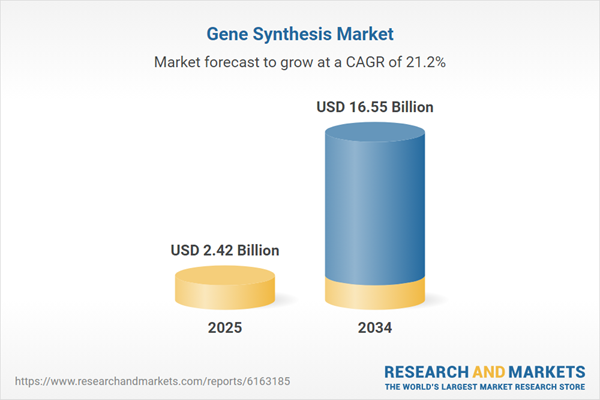Gene Synthesis: Introduction
Gene synthesis is a method which is used to generate or produce artificial genes in the laboratory. It enables the scientists to design and build custom DNA sequences that can later be used to manipulate the behaviours and characteristics of organisms or humans. Scientists insert these altered DNA into the body of the target and then observe the outcomes of the underlying experiments or trials. The complete process of gene synthesis consists of five steps including design, synthesis, assembly, verification, and expression. At first, the designing of sequence is being done by keeping the expected functionality of the living cell in mind. Then the gene synthesis takes place which is processed chemically. The basic building blocks of DNA (adenine, thymine, guanine, and cytosine) are linked together in the order specified by the design. The small, synthesized fragments are then assembled into full-length genes. This can be done with the use of a variety of methods such as polymerase chain reaction (PCR). Then happens the verification.It is basically matching the intended design with the outcome of assembled gene. The synthesized gene at this stage is ready to be inserted into a living cell (like a bacteria or yeast cell) to express the gene, which means that the cell will read the DNA sequence and produce the protein that the gene has been coded for.
Global Gene Synthesis Market Analysis
Gene synthesis can be used in various fields including vaccine development, drug discovery, agricultural biotechnology, and many other areas of biotechnology and life sciences. The increasing demand of gene synthesis in the fields such as pharmaceuticals and biotechnology industries has been driving the global gene synthesis market growth. The gene synthesis is widely applicable in the development of drugs. Pharmaceutical companies along with biotech companies are suing gene synthesis to develop new therapies such as personalized medicines and vaccines.Additionally, the increasing technological advancements in the field of synthetic biology are making gene synthesis to be more efficient and cost-effective. This includes updating gene design software, DNA synthesis and assembly technologies, and techniques for integrating synthetic genes into host organisms. The market is witnessing increased funding and investment from both public and private sources. This is leading to increased rate of research and development activities and more innovation. The global gene synthesis market development is driven by the increased focus on using gene synthesis for agricultural applications, such as the development of genetically modified crops with improved traits.
Global Gene Synthesis Market Segmentation
The report titled “Gene Synthesis Market Report and Forecast 2025-2034” offers a detailed analysis of the market based on the following segments:Market Breakup by Components
- Synthesizer
- Consumables
- Software and Services
Market Breakup by Gene Therapy
- Standard Gene
- Express Gene
- Complex Gene
- Others
Market Breakup by Application
- Synthetic Biology
- Genetic Engineering
- Vaccine Design
- Therapeutics Antibodies
- Others
Market Breakup by Gene Synthesis Type
- Gene Library Synthesis
- Solid Phase Synthesis
- Chip-Based DNA Synthesis
- PCR-Based Enzyme Synthesis
Market Breakup by Region
- North America
- Europe
- Asia Pacific
- Latin America
- Middle East and Africa
Global Gene Synthesis Market Overview
The increasing research and development in the fields of synthetic biology and genomics is driving demand for gene synthesis services. This is especially prevalent in sectors pharmaceuticals sector along with biotechnology, and academia. The increasing technological advancements in the field have made gene synthesis more efficient, accurate, and affordable which is helping in the market growth. Developments in next-generation sequencing, bioinformatics, and gene editing technologies (like CRISPR) are also directly contributing to market growth. The gene synthesis has been increasingly used in the discovery and development of novel drugs and therapeutics, including personalized medicines and vaccines.Additionally, the increasing prevalence of genetic disorders worldwide is also driving the demand for effective genetic therapies boosting the market. There has been a rise in funding and investments from government and private sectors for research activities that are fuelling the global gene synthesis market expansion.
Global Gene Synthesis Market: Competitor Landscape
The key features of the market report include patent analysis, grants analysis, clinical trials analysis, funding and investment analysis, partnerships, and collaborations analysis by the leading key players. The major companies in the market are as follows:- ATDBio Ltd
- General Biosystems
- Macrogen CO.
- Boster Biological Technology
- Creative Biogene
- Bioneer Pacific,
- Exonbio
- trenzyme GmbH
- Twist Bioscience
- BioCat GmbH
- OriGene Technologies, Inc.
- Integrated DNA Technologies
- Eurofins Scientific
- NZYTech
- Genes and Enzymes
This product will be delivered within 3-5 business days.
Table of Contents
Companies Mentioned
- ATDBio Ltd
- General Biosystems
- Macrogen CO.
- Boster Biological Technology
- Creative Biogene
- Bioneer Pacific,
- Exonbio
- trenzyme GmbH
- Twist Bioscience
- BioCat GmbH
- OriGene Technologies, Inc.
- Integrated DNA Technologies
- Eurofins Scientific
- NZYTech
- Genes and Enzymes
Table Information
| Report Attribute | Details |
|---|---|
| No. of Pages | 350 |
| Published | July 2025 |
| Forecast Period | 2025 - 2034 |
| Estimated Market Value ( USD | $ 2.42 Billion |
| Forecasted Market Value ( USD | $ 16.55 Billion |
| Compound Annual Growth Rate | 21.2% |
| Regions Covered | Global |
| No. of Companies Mentioned | 15 |









